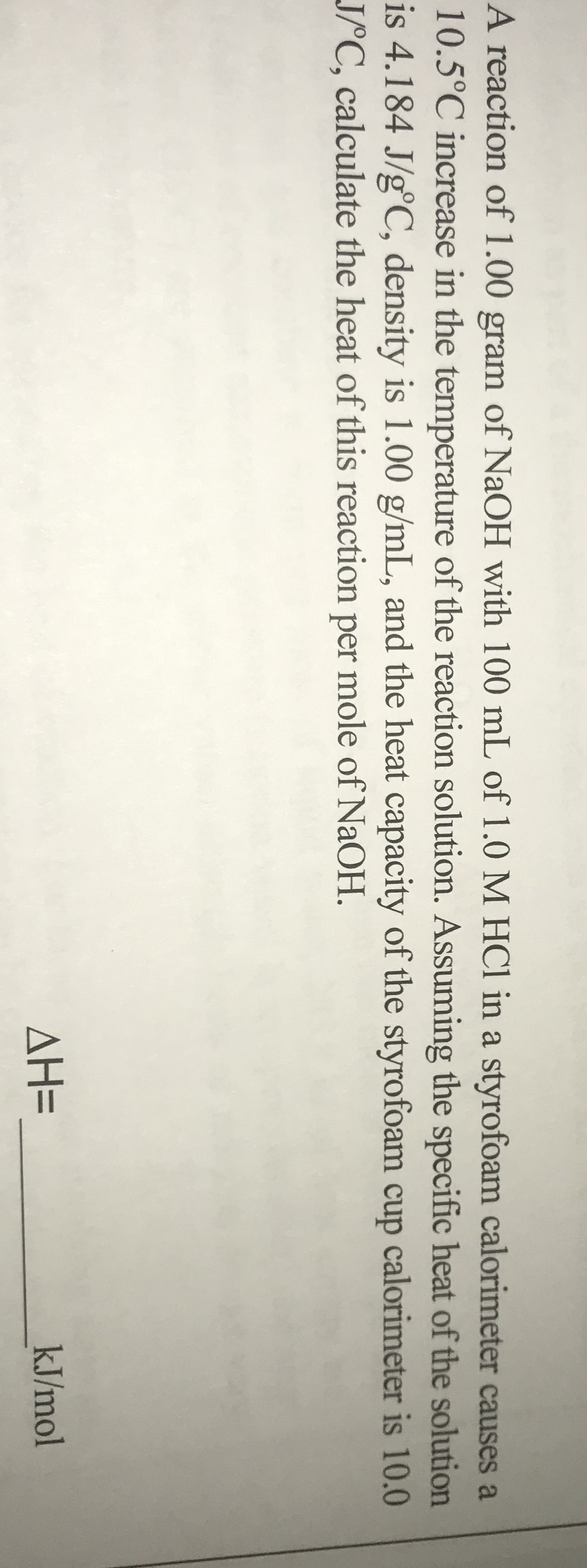
Chemistry
10th Edition
ISBN: 9781305957404
Author: Steven S. Zumdahl, Susan A. Zumdahl, Donald J. DeCoste
Publisher: Cengage Learning
expand_more
expand_more
format_list_bulleted
Question
thumb_up100%

Transcribed Image Text:A reaction of 1.00 gram of NaOH with 100 mL of 1.0 M HCl in a styrofoam calorimeter causes a
10.5°C increase in the temperature of the reaction solution. Assuming the specific heat of the solution
is 4.184 J/g°C, density is 1.00 g/mL, and the heat capacity of the styrofoam cup calorimeter is 10.0
JPC, calculate the heat of this reaction per mole of NaOH.
ΔΗΞ
kJ/mol
Expert Solution
This question has been solved!
Explore an expertly crafted, step-by-step solution for a thorough understanding of key concepts.
This is a popular solution
Trending nowThis is a popular solution!
Step by stepSolved in 3 steps with 3 images

Knowledge Booster
Similar questions
- A quantity of 85.0 mL of 0.600 M HCl is mixed with 85.0 mL of 0.600 M KOH in a constant-pressure calorimeter. The initial temperature of both solutions is the same at 17.35°C, and the final temperature of the mixed solution is 19.02°C. What is the heat capacity of the calorimeter? Assume that the specific heat of the solutions is the same as that of water and the molar heat of neutralization is −56.2 kJ/mol.arrow_forwardA piece of molybdenum metal whose mass is 6.87 g is heated to 100.0 °C and then dropped into an ice calorimeter. As the molybdenum cools to 0.0°C, 0.513 g of ice melts (it takes 6.01 kJ of heat to melt exactly 1 mol of ice). What is the molar heat capacity (in J/mol·K) of molybdenum? i J/mol*Karrow_forwarda chemist wastes a delicious brownie by burning it in a bomb calorimeter. before burning, the brownie weighed 16.13 grams. During the combustion process in the bomb calorimeter, the heat of the calorimeter increased by 7.40 degrees celsius. The known heat capacity of the calorimeter that was used was 26.53 kJ/Celsius. What is the energy content, in kJ/g, of this brownie?arrow_forward
- A 3.000 g sample of food was then burned in a calorimeter to determine its Calories per gram content. 50mL of water were used to determine ΔT of the reaction. Initial temperature of the water at the start of the combustion reaction was 20oC, final temperature was 99oC. Calorimeter constant for this calorimeter is 10.0J/oC. How much heat has been absorbed by the water sample?arrow_forwardA 32.1 g piece of aluminum (which has a molar heat capacity of 24.03 J/°C·mol) is heated to 82.4°C and dropped into a calorimeter containing water (specific heat capacity of water is 4.18 J/g°C) initially at 22.3°C. The final temperature of the water is 25.8°C. Calculate the mass of water in the calorimeter.arrow_forwardIn a coffee-cup calorimeter, 120.0 mL of 1.4 M NaOH and 120.0 mL of 1.4 M HCL are mixed. Both solutions were originally at 20.6°C. After the reaction, the final temperature is 30.0°C. Assuming that all the solutions have a density of 1.0 and a specific heat capacity of 4.18 J/°C·g, calculate the enthalpy change for the neutralization of HCL by NaOH . Assume that no heat is lost to the surroundings or to the calorimeter. ΔH = kJ/molarrow_forward
- When 1.366 grams of sucrose (Molar mass 342.3 g/mol) is burned in a bomb calorimeter, the temperature of the calorimeter increases from 22.41°C to 26.63°C. If the heat capacity of the calorimeter is 4.900 kJ/°C, what is the heat of combustion of sucrose?arrow_forward25.00 mL of 0.200 M sulfuric acid was added to 25.00 mL of 0.200 M NAOH, in a constant volume calorimeter. The density of the resulting solution is 1.225 g/mL and its specific heat is 5.321 J/g-°C. As the reaction took place, the temperature of the solution rose from 22.0 °C to 31.3 °C. What is AH (in units of kJ/mol) for the reaction, per mole of water formed? This is a limiting reactant problem and your choice of limiting reactant must be justified through stoichiometric calculations. 21.arrow_forwardIn a coffee-cup calorimeter, 110.0 mL of 1.3 M and 110.0 mL of 1.3 M are mixed. Both solutions were originally at 22.2°C. After the reaction, the final temperature is 30.9°C. Assuming that all the solutions have a density of 1.0 and a specific heat capacity of 4.18 J/°C·g, calculate the enthalpy change for the neutralization of HCl by NaOH in (kJ/mol). Assume that no heat is lost to the surroundings or to the calorimeter.arrow_forward
arrow_back_ios
arrow_forward_ios
Recommended textbooks for you
 ChemistryChemistryISBN:9781305957404Author:Steven S. Zumdahl, Susan A. Zumdahl, Donald J. DeCostePublisher:Cengage Learning
ChemistryChemistryISBN:9781305957404Author:Steven S. Zumdahl, Susan A. Zumdahl, Donald J. DeCostePublisher:Cengage Learning ChemistryChemistryISBN:9781259911156Author:Raymond Chang Dr., Jason Overby ProfessorPublisher:McGraw-Hill Education
ChemistryChemistryISBN:9781259911156Author:Raymond Chang Dr., Jason Overby ProfessorPublisher:McGraw-Hill Education Principles of Instrumental AnalysisChemistryISBN:9781305577213Author:Douglas A. Skoog, F. James Holler, Stanley R. CrouchPublisher:Cengage Learning
Principles of Instrumental AnalysisChemistryISBN:9781305577213Author:Douglas A. Skoog, F. James Holler, Stanley R. CrouchPublisher:Cengage Learning Organic ChemistryChemistryISBN:9780078021558Author:Janice Gorzynski Smith Dr.Publisher:McGraw-Hill Education
Organic ChemistryChemistryISBN:9780078021558Author:Janice Gorzynski Smith Dr.Publisher:McGraw-Hill Education Chemistry: Principles and ReactionsChemistryISBN:9781305079373Author:William L. Masterton, Cecile N. HurleyPublisher:Cengage Learning
Chemistry: Principles and ReactionsChemistryISBN:9781305079373Author:William L. Masterton, Cecile N. HurleyPublisher:Cengage Learning Elementary Principles of Chemical Processes, Bind...ChemistryISBN:9781118431221Author:Richard M. Felder, Ronald W. Rousseau, Lisa G. BullardPublisher:WILEY
Elementary Principles of Chemical Processes, Bind...ChemistryISBN:9781118431221Author:Richard M. Felder, Ronald W. Rousseau, Lisa G. BullardPublisher:WILEY

Chemistry
Chemistry
ISBN:9781305957404
Author:Steven S. Zumdahl, Susan A. Zumdahl, Donald J. DeCoste
Publisher:Cengage Learning

Chemistry
Chemistry
ISBN:9781259911156
Author:Raymond Chang Dr., Jason Overby Professor
Publisher:McGraw-Hill Education

Principles of Instrumental Analysis
Chemistry
ISBN:9781305577213
Author:Douglas A. Skoog, F. James Holler, Stanley R. Crouch
Publisher:Cengage Learning

Organic Chemistry
Chemistry
ISBN:9780078021558
Author:Janice Gorzynski Smith Dr.
Publisher:McGraw-Hill Education

Chemistry: Principles and Reactions
Chemistry
ISBN:9781305079373
Author:William L. Masterton, Cecile N. Hurley
Publisher:Cengage Learning

Elementary Principles of Chemical Processes, Bind...
Chemistry
ISBN:9781118431221
Author:Richard M. Felder, Ronald W. Rousseau, Lisa G. Bullard
Publisher:WILEY